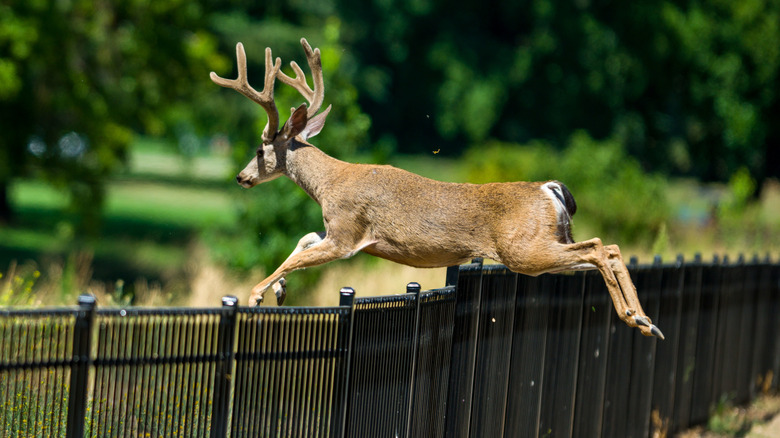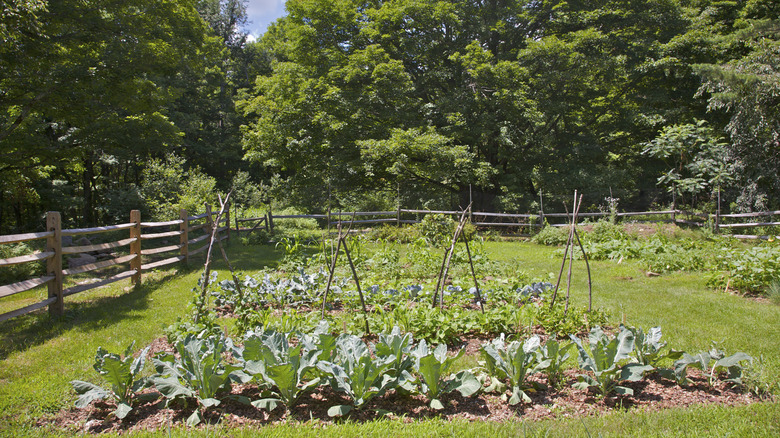How To Turn A Short Garden Fence Into One That Keeps Deer Out
Did you know that an adult male deer can jump a 12-foot fence if he gets a running start? Even without the advantage of speed, a deer can clear an 8-foot fence from a standstill. So, while there are many fence ideas to keep animals out of your veggies, that little garden fence you put up probably isn't going to keep a deer from munching on your tomatoes. The good news is that deer are cautious creatures, and if you're not above playing some psychological tricks on them, you can keep them out of your garden without erecting a fortress. By extending your existing posts, adding two levels of wire at strategic heights, and stringing a white clothesline or cord a few feet inside of the fence line, you can make deer think twice about trying to jump your garden fence.
It may sound complicated now, but the idea is simple and inexpensive. By building two fences — we use that term loosely here — and playing on the deer's natural sense of caution and lack of depth perception, you can create a fence that makes the deer think, "Jumping this is not worth the risk." As long as you get your heights right, you should be able to deter the vast majority of deer from getting in your garden.
How to extend your existing fence posts
Let's say you have a 4-foot fence around your garden, built with wooden posts that are anchored into the soil. You will need to extend the posts to at least 8 feet tall to have a chance of deterring most deer. An inexpensive way to accomplish this is by adding T-posts to create more height. While you can use other materials, such as wood, these have pre-existing hooks that will make it easy to string the wire in the next step.
A 5-foot length of T-post will cost roughly $6, and will allow you plenty of room to adjust the final height. Use the pre-drilled holes to screw it into your fence posts, leaving at least 4 feet to extend above your current fence. Of course, your new 8-foot tall posts are not helpful if the deer can just jump between them. This is where your wire comes in.
Run the wire around your post in two levels at about 5 and 7 feet from the ground. If you have old rolls of chicken wire or other free materials that you can use instead of the wire, feel free to improvise. That's a great way to make this inexpensive fencing option even cheaper, and chicken wire can be a good way to deter deer from destroying your garden on its own. If you opt for the wire, the deer won't want to jump through this, so their only option is to go over, which they could still easily do.
The inside 'fence'
Inside your newly extended fence, you will want to create a second perimeter, about 3 feet from the main fence. This should be close enough that the deer won't attempt to either jump both fences or land in between. You can use more T-posts or whatever scrap wood you might have around to create these posts, but you will want them to be at least 4.5 feet tall so you can run string at about this height. Another option, especially for smaller gardens with slightly taller fences, is to tie the string to your existing fence at the right height and distance from the side to which it runs parallel. The key is to get it taut.
You can use something like a nylon rope, a clothesline, or really any sturdy, white material like braided polypropylene tape. The most important factor in this equation is the color. You want it to be easily visible to a deer standing on the other side of the fence trying to decide if it is safe to jump. The goal is for the deer to see this second fence and decide it presents a potential hazard, and to move on. So, it has to be highly visible. If you don't already have a garden fence or need more fence-building advice, check out these 15 tips for building the perfect fence.

